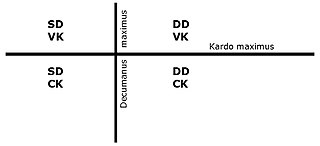Cardo


The Cardo (also: Kardo ) describes the main axis laid out when a Roman city was built , which was mostly laid out in a north-south direction. An axis, called the decumanus , was set perpendicular to this main axis and ran mostly in an east-west direction . The intersection of these main axes marks the center of the city.
The establishment of the main axes was viewed as a religious act in which a priest was originally always present. Since the main axes were determined with the help of a groma , the point of intersection of the main axes is also called a groma (more precisely: locus gromae ).
More precisely, the main axes are referred to as cardo maximus or decumanus maximus , since secondary axes were created parallel to the main axes. The resulting chessboard-like city map can still be seen today in the layout of many cities that were founded in Rome.
This form of construction is particularly found in Roman forts , where the main axes are also referred to as via principalis (cardo maximus) or via praetoria (decumanus maximus).
See also
literature
- Okko Behrends, Luigi Capogrossi Colognesi (ed.): The Roman art of field measurement. Interdisciplinary contributions on their significance for the history of civilization in Rome. Vandenhoeck and Ruprecht, Göttingen 1992, ISBN 3-525-82480-7
- Oswald Ashton Wentworth Dilke: The Roman land surveyors. An introduction to the Agrimensores. Hakkert, Amsterdam 1992, ISBN 90-256-1000-5 . Reprint of the 1971 Newton Abbot edition.
- Ursula Heimberg : Roman land surveying. Small writings on the knowledge of the Roman occupation history of Southwest Germany No. 17. Society for Prehistory and Early History in Württemberg and Hohenzollern / Württembergisches Landesmuseum, Stuttgart 1977
- Werner Müller: The holy city - Roma quadrata, Jerusalem and the myth of the world navel. Kohlhammer, Stuttgart 1961.
- Charlotte Schubert: Land and Space in the Roman Republic - the art of sharing. Scientific Book Society, Darmstadt 1996, ISBN 3-534-13189-4